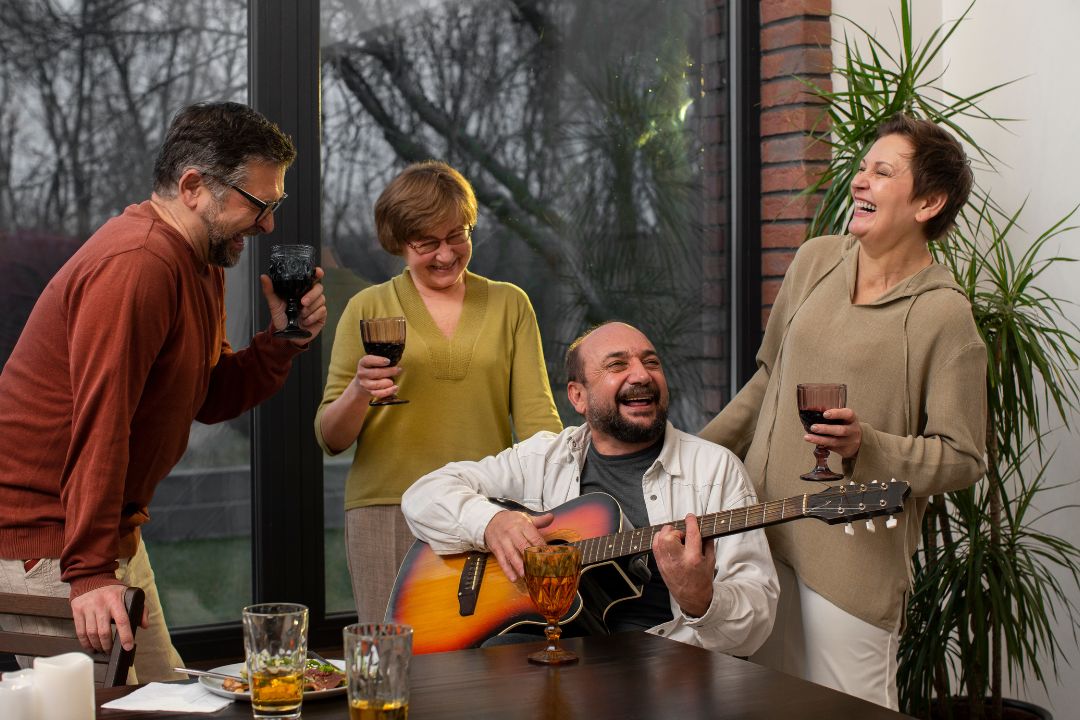Retirement today is not simply about slowing down; it’s about living fully. Many retirees are redefining what it means to enjoy later life, and a growing priority is social living in retirement. Staying socially connected isn’t just enjoyable; it supports healthy aging, boosts mental wellness, and enhances longevity.
Modern 55+ communities and active adult communities are responding by creating environments that foster connection. These communities are designed to enable residents to live actively, socially, and purposefully. From vibrant clubhouses and hobby groups to digital platforms connecting residents anytime, social engagement is central to the retirement lifestyle.
This guide will explore how social living works in 55+ communities, why it matters for retirees, and how to choose a community that supports wellness, connection, and purpose.
Why Social Living Matters in Retirement
Strong social engagement in retirement isn’t just enjoyable, it’s vital to wellness. Studies show that retirees who maintain active social lives experience lower rates of depression and cognitive decline, live longer, and report higher satisfaction. Senior living communities that embed social connection into their daily life design promote a healthier, more fulfilling retirement lifestyle.
Social living is now widely recognized as a key pillar of retirement wellness. Active adult communities are increasingly emphasizing connection, ensuring retirees have meaningful opportunities to engage every day.
How 55+ Communities Foster Social Living

Clubhouses are the beating heart of many active adult communities. These central spaces are designed to encourage interaction and exploration. Dining rooms and coffee lounges create relaxed spaces for casual conversations, while game rooms and theater spaces host entertainment and gatherings. Fitness centers and wellness studios offer group classes that promote both physical health and social connection, while art studios and libraries provide cultural outlets for residents. Multipurpose rooms host celebrations, educational events, and community meetings, making connection a natural part of daily life.
Interest-based clubs are another cornerstone of social engagement in senior living communities. Gardening clubs connect nature lovers, book clubs bring together curious minds, and art workshops foster creativity. Cooking classes and wine clubs offer cultural enrichment and shared experiences. These interest groups build friendships while encouraging learning and personal growth.
Fitness and wellness programs also blend health with social interaction. Group yoga, tai chi, and Pilates classes promote mindfulness, while walking and hiking groups create community through activity. Pickleball and tennis leagues offer friendly competition, and aquatic fitness classes provide low-impact ways to stay active together. These programs create opportunities for physical wellness while strengthening bonds between residents.
Special events and trips make retirement living vibrant and fulfilling. Wine tastings, culinary festivals, seasonal celebrations, and themed parties create memorable moments and foster deeper community connections. Many communities also organize group travel experiences, allowing residents to explore new destinations together. These shared adventures foster a sense of belonging and enrich retirement life.
Volunteer opportunities help retirees find purpose. Many communities partner with local organizations to offer mentorship programs, environmental clean-ups, and charity projects. These activities not only give back to the broader community but also build lasting friendships among residents.
Digital tools have also transformed social living in retirement. Many communities now offer apps and online portals for event calendars, discussion forums, and virtual meetups. These tools help residents stay engaged even when they can’t attend in person, making it easier to maintain social connections in a modern retirement lifestyle.
Current Trends in Social Living for Retirement Communities
Social living continues to evolve as retirees’ needs and lifestyles change. One ongoing trend is the integration of technology-driven connection tools. Resident portals, virtual hobby groups, and online event platforms make it easier to stay connected regardless of physical ability or location.
Another enduring trend is the emphasis on wellness and sustainability. Many communities now offer green spaces, environmentally friendly amenities, and wellness programs tailored to individual needs. Personalized health and lifestyle programming continues to gain importance, enabling retirees to maintain their vitality and independence.
Finally, retirees are increasingly seeking communities where social living is an integral part of the culture, where activities, spaces, and programs naturally foster connection and engagement. Communities that prioritize this holistic lifestyle will continue to lead in senior living innovation for years to come.
Why Social Living is Growing in Popularity
Several factors are driving the growth of social living in retirement. Longer lifespans mean retirees want meaningful experiences for decades beyond traditional retirement. Technology makes it easier than ever to connect and stay involved. Awareness of the link between social interaction and wellness is growing, and retirees are increasingly prioritizing community and engagement when deciding where to live. Social living is now a defining element of the retirement lifestyle.
Choosing a 55+ Community That Fosters Social Living

When choosing an active adult community, retirees should consider amenities that promote social connection, such as clubhouses, fitness centers, hobby spaces, and multipurpose rooms. A robust activity calendar with a diverse range of events is essential. Community culture matters; residents should feel welcome and connected to their surroundings. Digital tools for communication and event organization make social living easy. Location is also essential; proximity to cultural, leisure, and outdoor opportunities can greatly enrich life in retirement.
Benefits of Social Living for Retirees
Social living offers retirees clear benefits. It improves mental health by reducing stress and loneliness, enhances physical wellness through group activity, and fosters emotional well-being through friendships and shared experiences. Participation in community events and volunteer opportunities gives retirees a sense of purpose. Ultimately, social living transforms retirement into a fulfilling chapter, filled with connection, growth, and joy.
Conclusion
Retirement is evolving. It’s no longer just about where you live; it’s about how you live. Social living is a cornerstone of active adult communities and a vital component of a healthy retirement. Choosing a 55+ community that prioritizes connection, wellness, and engagement is selecting a retirement lifestyle filled with purpose, joy, and a sense of belonging.
Explore active adult communities that excel in social living at ActiveAdultLiving.com.




